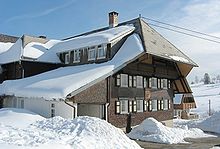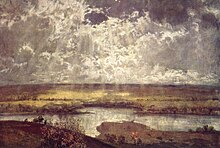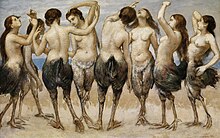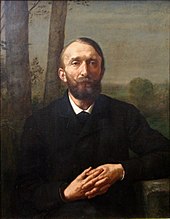Hans Thoma
Hans Thoma (born October 2, 1839 in Oberlehen, Bernau in the Black Forest , today district of Waldshut ; † November 7, 1924 in Karlsruhe ) was a German painter and graphic artist.
Life
Origin and education

Hans Thoma came from a humble background. His father Franz Joseph Thoma (1794–1855) was a trained miller and worked as a woodworker in the Black Forest . His mother Rosa Thoma (1804-1897), née Mayer, came from a family of artisans. Her grandfather came from Menzenschwand and was a brother of the grandfather of Franz Xaver and Hermann Winterhalter .
He broke off the apprenticeship he had begun, first as a lithographer and house painter in Basel , then as a clock shield painter in Furtwangen . He did autodidactic painting and drawing studies before he was accepted into the Grand Ducal Art School in Karlsruhe in 1859 , where he was a student of Johann Wilhelm Schirmer and Ludwig Des Coudres , among others . Thoma finished his studies in 1866.
Wandering years

After stays in Basel and Düsseldorf (1867–1868), he went to Paris with Otto Scholderer in 1868 , where he was particularly impressed by the works of Gustave Courbet and the Barbizon School . Thoma finally went to Munich, the then art capital of Germany. He lived there from 1870 to 1876. In 1874 he traveled to Italy for the first time.
In 1877 Thoma married the flower and still life painter Cella Berteneder . A second trip to Italy followed in 1880, after having toured England in 1879 and exhibiting there in 1884 at the Art Club Liverpool. He was friends with Arnold Böcklin and was close to the Leibl group .
Frankfurt and Kronberg

From 1878 Thoma lived in Frankfurt's Westend, house to house with his painter friend Wilhelm Steinhausen , and in a common household with his wife, his sister Agathe and with Ella, the niece of his wife who was adopted in 1878. There he met the SDAP politician, ex-boarding school director and private scholar Samuel Spier , who lives in the neighborhood (Mendelssohnstrasse 69), and his wife, the writer and art critic Anna Spier. The Spiers as well as other acquaintances of Steinhausen supported Thoma with commissions. Anna Spier wrote articles and a portrait in book form about him; Thoma created an ex-libris for her and painted a portrait, which is now in the Germanic National Museum in Nuremberg.
From 1886 to 1899 he lived at 150 Wolfsgangstrasse in Frankfurt and from 1896 to 1898 at the same time in Oberursel at 20 Taunusstrasse (today Altkönigstrasse 20). Inscriptions on both houses indicate this. During this time the frieze with mythological scenes in Palais Pringsheim in Munich was created. At times it housed the writer Julius Langbehn . The builder of Thomas's house, Simon Ravenstein , supported Thoma with numerous orders, the first of which was in 1882 to paint the house of the architect himself.
Thoma was close to the painters of the Kronberg painters' colony . In 1899 the family of four moved into an apartment with a studio next to the Friedrichshof in Kronberg im Taunus , which Thoma perceived as a visible expression of the long-awaited recognition as a painter.
Karlsruhe

In 1899 Hans Thoma was appointed professor at the Grand Ducal Art School in Karlsruhe and director of the Kunsthalle Karlsruhe . He held this office until 1920. In the art gallery he furnished the Thoma chapel , which can still be seen there today; An extension with the Thoma Museum opened on his 70th birthday . The time in Karlsruhe was overshadowed by the death of his wife Cella in 1901, which made Thoma depressed for years. Thoma now lived with his sister in Karlsruhe.
Since his exhibition at the Münchner Kunstverein in 1890, he has been widely recognized in Germany. Until around 1910, Thoma was one of the most respected painters in Germany. Meyer's Großes Konversations-Lexikon recorded in 1909 that he had become “one of the favorite painters of the German people”, a term used in 2013 by the Städel Museum in Frankfurt with the exhibition Hans Thoma. "Favorite painter of the German people" was picked up.
From 1905 to 1918 Thoma was a member of the First Chamber of the Baden State Parliament appointed by the Grand Duke . In October 1914 he was one of the signatories of the Manifesto of 93 , the text of which tried to defend German militarism at the beginning of the First World War and denied that war atrocities had taken place in Belgium. In 1919 Ernst Oppler and Lovis Corinth organized a birthday party on the occasion of his 80th birthday.
Artistic development and importance


Thomas early works are characterized by a lyrical pantheism . During his time in Munich, he mainly painted landscapes. In Frankfurt, works with narrative or allegorical content were the focus of his work. In old age he worked intensively on his "Thoma Chapel", which he decorated with scenes from the life and ministry of Jesus Christ .
His landscapes ( Black Forest , Upper Rhine Plain and Taunus ) and the portraits of his friends and relatives as well as his self-portraits are still considered his best and most authentic works . Less convincing today are often grotesquely exaggerated, realistic, mythological- religious depictions that were strongly influenced by Arnold Böcklin .
He was one of the preferred selection of contemporary artists that the committee for the procurement and evaluation of Stollwerck pictures suggested to the Cologne chocolate producer Ludwig Stollwerck for commissioning with designs.
The art historian Henry Thode stylized Thomas's work into an embodiment of national identity, which paved the way for the appropriation by the National Socialist art criticism . The article Kampfbund für deutsche Kultur gives an indication of how folk-minded circles developed the Hans-Thoma-Schule in Karlsruhe into a center of German tumultuous currents (anti-Semitism, anti-capitalism and local art).
Thomas's students included the later head of the Landshut Ceramic School, Hermann Haas .
Biographical and artistic parallels to Thoma can be found in the somewhat younger Frankfurt artist Johann Georg Mohr .
Honors
- In 1949, Mayor Ludwig Baur founded the Hans-Thoma-Kunstmuseum in Bernau in the Black Forest , in which oil paintings, graphics, arts and crafts and life documents give an insight into the artist's work.
- In Oberursel , the Hans Thoma memorial site in the Vortaunus Museum shows original Thomas.
- The Hans Thoma Prize was named after him, the state award of the state of Baden-Württemberg for visual artists.
- Several schools, mainly in Baden-Württemberg, bear the painter's name, including the Hans-Thoma-Gymnasium Lörrach .
- Many streets and squares such as those in Berlin , Bremen , Frankfurt am Main , Heidelberg , Karlsruhe , Mannheim , Potsdam and Wiesbaden were named after him.
- A stone portrait of Thomas is one of the figures who decorate the columns of the Stephanienbrunnen in Karlsruhe as gargoyles .
- On September 1, 1993 an asteroid was named after him: (5492) Thoma .
Major works
- The bee friend , 1863, Kunsthalle Karlsruhe
- Black Forest Landscape , 1867, Kunsthalle Bremen
- Portraits of mother and sister , 1868, Museum Folkwang Essen
- The goatherd , 1869, Landesmuseum Mainz
- Black Forest Landscape , 1872, Berlin State Museums
- Children's dance , 1872, landscape format, Kunsthalle Karlsruhe
- The Rhine near Säckingen , 1873, Hans-Thoma-Museum Bernau
- The Rhine near Säckingen , 1873, Alte Nationalgalerie Berlin
- Singing in the Green , around 1875, Landesmuseum Hannover
- Religious Instruction , 1878, private property
- Lemon seller , 1880, Sander Collection
- Taunus landscapes , 1881 and 1890, Neue Pinakothek Munich
- Kinderreigen , 1884, portrait format, private collection
- The art writer Conrad Fiedler , 1884, Alte Nationalgalerie Berlin
- Archers , 1887, Alte Nationalgalerie Berlin
- Der Angler , 1888, Städtische Kunstsammlungen Bonn
- Mondscheingeiger , 1890, private property
- The Guardian of the Valley , 1893, Galerie Neue Meister Dresden
- Valley near Bernau , 1904, Hans-Thoma-Kunstmuseum Bernau
- The wandering brook , 1906
- Series of twelve monthly, eight planetary and ten Christ pictures, 1906–1908, Kunsthalle Karlsruhe
The most important Thoma collections are owned by the Städelsche Kunstinstitut in Frankfurt and the Staatliche Kunsthalle Karlsruhe.
Publications
- The landscape painter. A coloring book for children. 1904 ( digitized version )
- Festive calendar by Hans Thoma. Publishing house by EA Seemann, Leipzig. Folder with 31 colored boards ( pictures [commons]).
- In the autumn of life. Collected memory sheets. 1909
- In the winter of life. Life memories. 1919 ( zeno.org ).
- Ways to peace. 1919
- Yearbook of the soul. 1922
Exhibitions (selection)
- 2011: An interview with Hans Thoma. Dreiländermuseum Loerrach.
- 2013: Hans Thoma. Favorite painter of the German people. Städel Museum , Frankfurt am Main; with catalog.
- 2014: Hans Thoma. Stations of an artist's life. Hans-Thoma-Kunstmuseum, Bernau in the Black Forest.
- 2018: Hans Thoma. Wanderer between the worlds. Museum LA8 , Karlsruhe; with catalog.
literature
- Franz Hermann Meissner: Hans Thoma. Schuster & Loeffler, Berlin / Leipzig 1899 ( archive.org ).
- Fritz von Ostini Thoma. Published by Velhagen and Klasing, Bielefeld / Leipzig 1900.
- A. [nna] Spier: Hans Thoma. A portrait. Heinrich Keller, Frankfurt a. M. 1900.
- A. [nna] Spier: Hans Thoma. in: The art of our time. 11th year. 1st half band. Franz Hanfstaengl, Munich 1900, pp. 61–112. ( Text archive - Internet Archive ).
- Henry Thode: Thoma. The master's painting in 874 ills. Deutsche Verlagsanstalt, Stuttgart / Leipzig 1909.
- Thoma folder. Published by the art warden. Georg DW Callwey at Kunstwart-Verlag, Munich, around 1910. (Folder with 26 colored plates and booklet.)
- Karl Josef Friedrich (Ed.): The Hans Thoma book. Gift of friend for the master's 80th birthdays. EA Seemann, Leipzig 1919.
- Joseph August Beringer : Hans Thoma. F. Bruckmann, Munich 1922 ( archive.org ).
- Karl Anton: Hans Thoma, a master of humanity. G. Braun, Karlsruhe 1924.
- M. Spanier: Hans Thoma and his art for the people. Breitkopf and Härtel, Leipzig 2nd edition 1925.
- Hans Vollmer: Thoma, Hans . In: Hans Vollmer (Hrsg.): General lexicon of fine artists from antiquity to the present . Founded by Ulrich Thieme and Felix Becker . tape 33 : Theodotos vacation . EA Seemann, Leipzig 1939, p. 47-51 .
- Lili Fehrle-Burger: The paintings by Hans Thoma in the Peterskirche. In: Heidelberger Fremdblatt. 7, 1961, pp. 2-6.
- Hans Thoma. Exhibition catalog. Karlsruhe 1974.
- Augustinermuseum Freiburg (Ed.): Hans Thoma. Life pictures. Painting exhibition for the 150th birthday. Langewiesche, Königstein / Taunus 1989, ISBN 3-7845-7870-X
- Christa von Helmolt: Hans Thoma. Mirror images. Klett-Cotta, Stuttgart 1989, ISBN 3-608-76261-2 .
- Ursula Peters: Mrs. Anna Spier, portrayed by Hans Thoma. In: Monthly Gazette of the Germanisches Nationalmuseum, No. 145. Nuremberg 1993, pp. 1163–1166.
- Jan Lauts : Hans Thoma. Langewiesche, Königstein / Taunus 1995, ISBN 3-7845-1671-8 .
- Exhibition cat .: Temporary idyll. Painting holidays at Untersee 1880 to 1914. ( Städt. Wessenberg-Galerie ) Konstanz 2009.
- Hans Peter Buohler: [Art.] Thoma, Hans. In: Killy Literature Lexicon. Authors and works from the German-speaking cultural area. Lim. by Walther Killy, ed. by Wilhelm Kühlmann (among others). Second, completely revised. Edition. Volume 11. de Gruyter, Berlin / New York 2011, ISBN 978-3-11-022040-7 , pp. 484-486.
- Felix Krämer, Max Hollein (Ed.): Hans Thoma. 'Favorite painter of the German people'. Cologne 2013, ISBN 978-3-86832-154-8 .
- Hans-Thoma-Kunstmuseum Bernau in the Black Forest (Hrsg.): Hans Thoma. Stations of an artist's life. Michael Imhof Verlag, Petersberg 2014, ISBN 978-3-7319-0009-2 .
Web links
- Literature by and about Hans Thoma in the catalog of the German National Library
- Works by and about Hans Thoma in the German Digital Library
- Hans-Thoma-Museum in Bernau
- Objects in the Dreiländermuseum collection database
- Autographs by Hans Thomas in the digital collections of the Badische Landesbibliothek
- Speeches by Hans Thoma in the Baden state parliament in the digital collections of the Badische Landesbibliothek
- The dispute over the painter Hans Thoma. SWR2 worth reading conversation from February 12, 2019 (recording from the LA8 museum of March 3, 2018)
Individual evidence
- ^ Emil Baader : Franz Xaver Winterhalter (1805–1873), the European prince painter. ( Memento of the original from March 4, 2016 in the Internet Archive ) Info: The archive link was inserted automatically and has not yet been checked. Please check the original and archive link according to the instructions and then remove this notice. In: Badische Heimat. 40. Freiburg im Breisgau 1960, pp. 367-376.
- ↑ Bernau: Even with a white beard, the "boy". (No longer available online.) Suedkurier.de, March 5, 2004, archived from the original on March 24, 2016 ; Retrieved March 19, 2016 . Info: The archive link was inserted automatically and has not yet been checked. Please check the original and archive link according to the instructions and then remove this notice.
- ↑ Thoma, Hans . In: Biographical Artist Lexicon. Leipzig 1882, p. 518.
- ↑ History - The collection in the 19th century ( page no longer available , search in web archives ) Info: The link was automatically marked as defective. Please check the link according to the instructions and then remove this notice. , Staatliche Kunsthalle Karlsruhe, accessed on May 30, 2010.
- ↑ Thoma, 2) Hans . In: Meyers Großes Konversations-Lexikon . 6th edition. Volume 19, Bibliographisches Institut, Leipzig / Vienna 1909, p. 493 .
- ↑ Hans Thoma. "Favorite painter of the German people". Overview exhibition in the Städel Museum from July 3 to September 29, 2013.
- ↑ Text of the manifest ( Memento of the original from February 17, 2010 in the Internet Archive ) Info: The archive link has been inserted automatically and has not yet been checked. Please check the original and archive link according to the instructions and then remove this notice.
- ↑ Thomas Corinth: Lovis Corinth - A Documentation. Ernst Wasmuth, 1979, p. 255.
- ↑ Detlef Lorenz: Advertising art around 1900. Artist lexicon for collecting pictures. Reimer-Verlag, 2000.
- ↑ Internet site of the Hans-Thoma-Kunstmuseum ( Memento of the original from December 21, 2017 in the Internet Archive ) Info: The archive link was automatically inserted and not yet checked. Please check the original and archive link according to the instructions and then remove this notice. .
| personal data | |
|---|---|
| SURNAME | Thoma, Hans |
| BRIEF DESCRIPTION | German painter and graphic artist |
| DATE OF BIRTH | October 2, 1839 |
| PLACE OF BIRTH | Bernau in the Black Forest |
| DATE OF DEATH | November 7, 1924 |
| Place of death | Karlsruhe |




